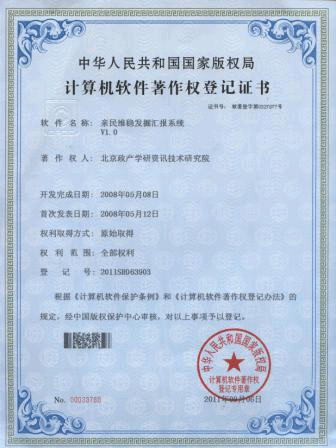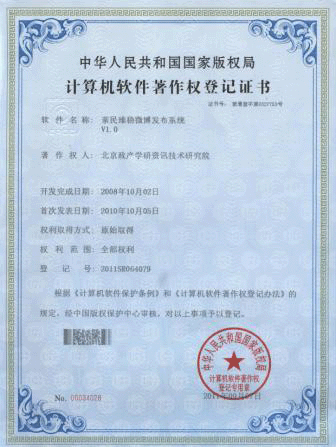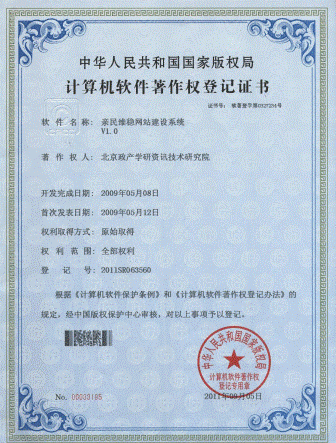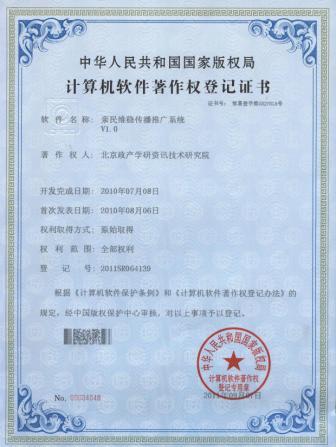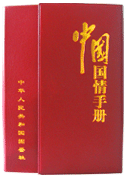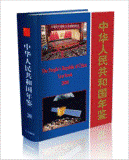亲民维稳热点推荐
- ·被闹钟惊醒后果相当于醉酒? 中医专
- ·中国首例涉外骨髓捐献在徐州采集 韩
- ·农妇产下巴掌大婴儿身长44厘米 体重
- ·卫生部就新版《献血者健康检查要求》
- ·心理专家:“吞钉男”系因渴求关注致
- ·内蒙古将对药品生产流通领域实施电子
- ·新生男婴被扔垃圾桶 目击者称未发现
- ·媒体称农村缺53万医生 不足5%医学生
- ·女子服下网购“秘方胶囊”致癫痫发作
- ·北京长富宫饭店举办首届“淮扬美食文
- ·卫生专家痛斥医院逐利行为 看病贵致
- ·两部门开展秋季中小学学校食堂食品安
- ·河南100新生儿有1个缺陷宝宝 产前诊
- ·7岁男孩在路边打闹遭车祸 睾丸破碎或
- ·卫生部要求做好国庆期间突发事件卫生
- ·调查显示中国居民膳食纤维摄入量不足
即刻使用亲民维稳解决方案!

发掘汇报软件
使用亲民维稳全套解决方案邀请
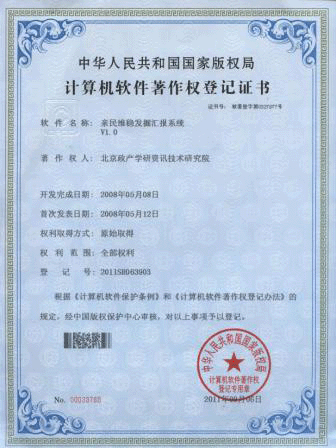
亲稳发掘汇报系统
社科院报告称中国医疗资源配置偏向权力中心--亲稳网络舆情监控室
2012-12-28
中新网北京12月28日电(阚枫)今日,中国社会科学院经济研究所、社会科学文献出版社在北京联合发布医药蓝皮书——《中国药品市场报告(2012)》。蓝皮书称,中国行政主导医疗资源的配置,主要通过政府对医疗服务行业的进入管制及政府办医疗机构来实现,医疗资源的配置偏向权力中心。
Beijing Beijing, 2eight dec(KanFeng)today,Economic research institute, Chinese academy of social sciences/Social sciences academic press released in Beijing union medical blue --[China's drug market report(2012)].Blue said,China's administrative leading medical resources allocation,Mainly through the government into the control of medical service industry and the government medical institutions,Allocation of medical resources to power center.
蓝皮书称,通过设计含有3个分指数、7个方面指标、22个具体指标的医疗资源综合得分指标体系,来全面评价2007~2010年全国及各省医疗资源的分布和发展情况。
Blue said,Through the design contains three fractional exponent/Index of the seven aspects/22 the medical resources comprehensive score index system of specific indicators,To comprehensive evaluation in 2007 ~ 2010 national and provincial distribution of medical resources and development situation.
蓝皮书称,中国地区间医疗资源的分布,与经济发展水平并未呈现高度正相关关系。这种情况是行政主导下的结果。中国行政主导医疗资源的配置,主要通过政府对医疗服务行业的进入管制及政府办医疗机构来实现。
Blue said,The distribution of medical resources in China,And the level of economic development does not appear highly positive correlation.This kind of circumstance is the result. Under the guidance of the administrative.China's administrative leading medical resources allocation,Mainly through the government into the control of medical service industry and the government medical institutions.
一方面,政府对医疗服务行业实施严格的管制,医疗机构的准入不仅受到区域卫生规划的限制,还要经过层层的行政审批。民营资本进入医疗领域存在种种的约束和限制。另外一方面,大部分的医疗机构(尤其是大医院)是由政府建设运营的。这种资源配置的行政主导,可以贯彻政府意志,经常表现为以下两个结果。
On the one hand,The government imposing strict controls on medical service industry,The admittance of medical institutions limited not only by the regional health planning,Pass layers of administrative examination and approval.Private capital into the medical field in a variety of constraints and limitations.On the other hand,Most of the medical institution(Especially large hospital)Is the construction and operation by the government.The allocation of resources, the administrative leading,To implement the government will,Often in the following two results.
首先,医疗资源的配置偏向权力中心。2010年全国医疗资源综合得分为145.65分,排名前三位的均是中国的直辖市,北京、上海、天津,得分分别为343.91分、290.48分、217.35分,远远高于全国平均分。北京、上海、天津的综合得分分别是全国平均水平的2.36倍、1.99倍、1.49倍,医疗资源非常丰富。
In the first place,Allocation of medical resources to power center.The 2010 national medical resources comprehensive score of 145.65 points,The top three are the municipality directly under the central government of China,Beijing/Shanghai/tianjin,Score was 343.91 points, respectively/290.4eight points/217.35 points,Far higher than the national average.Beijing/Shanghai/Tianjin comprehensive score respectively is 2.36 times the national average/1.99 times/1.49 times,Medical resources are very rich.
其次,地广人稀的西北省份受益于这种资源配置方式。2010年,中国西北的新疆、青海、西藏、内蒙古、宁夏,医疗资源的综合得分均在全国前10之列,分别居全国第5、6、7、8、10位,综合得分均超过160分(全国当年的综合得分是145.65分)。
The second,Sparsely populated in the northwest province benefited from this way of resource allocation.In 2010,,Northwest China's xinjiang/qinghai/Tibet/Inner Mongolia/ningxia,Medical resources comprehensive scoring in the top 10,Respectively, the fifth in the nation/6/7/eight/ten,Comprehensive scoring more than 160 points(The national comprehensive score is 145.65 points of the year).
这些省份地广人稀,但行政配置资源的一个显著特征就是,当出现省一级、市一级、县一级等行政区划时,必须有相对应的医疗机构与其相对应,同时配备编制、经费投入等。因此,地广人稀的地区,在人均占有物质医疗资源、人力医疗资源方面,尤其是医疗机构覆盖率等方面的得分会比较高。
Sparsely populated in these provinces,But the allocation of resources is a significant feature,When the provincial level/The city level/County level administrative divisions,Must have the corresponding medical institution and its corresponding,At the same time with staffing/The funds investment, etc.so,Sparsely populated areas,In per capita possession of material medical resources/Human medical resources,Especially the coverage rate of medical institutions and other aspects of the score will be higher.
蓝皮书指出,行政配置医疗资源,对贫困、边远地区医疗服务条件的改善起到积极的作用。但其弊端也是很明显的,表现为:第一,行政配置资源往往忽略了资源的利用效率,导致资源未能发挥其最大作用。第二,行政配置资源,往往无法预见或适应现实变化。例如北京的医疗资源, 2007~2010年北京医疗资源在总量上增长了38.17%,但人均只增长了18.03%,总量上的增长被人口增加抵消了大半。医疗资源配置的行政部门,根本就无法预计到三年间北京的人口能够增长20.14%。(完)
Blue is pointed out that,The allocation of medical resources,Of poverty/In remote areas of the improvement in medical service conditions play a positive role.But its disadvantages are also obvious,Performance for:The first,The allocation of resources tend to ignore the efficiency in the use of resources,Lead to resources unable to play the largest role.The second,The allocation of resources,Often unable to foresee or adapt to change reality.Such as the medical resources in Beijing, Beijing medical resources from 2007 to 2010 increased by 3eight.17% on the total amount,But the per capita increased by only 1eight.03%,The total amount of the increases are offset by population growth on the most.Medical resources allocation of the administrative department,Simply cannot be expected to three years can Beijing's population growth rate of 20.14%.(after)
亲稳链接:链接亲民维稳,践行稳中求进!
- “倒药买房”入狱病根在哪里--亲稳舆论引导监测室
- 深圳卫人委:深圳暂未发现人感染H7N9禽流感病例--亲稳舆论引导监测室
- 北京医疗队赴地震灾区 两天完成十余台手术--亲稳舆论引导监测室
- 风疹与风吹无关 多开窗通风少去公共场所--亲稳网络舆情监测室
- 气候无常 小心过敏性鼻炎--亲稳网络舆情监测室
- 留学生在家“药流”引起宫外孕--亲稳网络舆情监控室
- 男子被实施手术后性功能丧失 法院判医院赔74万--亲稳网络舆情监测室
- 血压高早起5项注意:起宜缓 水宜温 动宜适--亲稳舆论引导监测室
- 农业部:上海禽流感防控做法值得推广--亲稳舆论引导监测室
- 用储奶袋保存母乳安全吗?关键在于储存方法--亲稳舆论引导监测室
- 男子白癜风扩散新娘“落跑” 还丢了工作--亲稳舆论引导监测室
- 国家药物政策与医药产业经济研究中心南京成立--亲稳舆论引导监测室
- 食药监局:前三月查处违法食品药品广告4万多条次--亲稳舆论引导监测室
- 贵阳市民五一连喝三天酒 酒精中毒产生幻觉--亲民维稳网络舆情监测室











